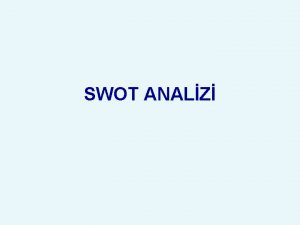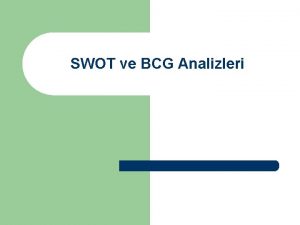Reema Al Haidar SWOT ANALYSIS Reema Al Haidar










- Slides: 10

Reema Al. Haidar SWOT ANALYSIS

Reema Al. Haidar What is SWOT analysis? • It’s is a strategic planning method used to evaluate the Strengths, Weaknesses, Opportunities, and Threats involved in a project or in a business. It involves identifying the internal and external factors that are favorable and unfavorable to achieve the objective of the business. The technique is credited to Albert Humphrey. • Assessing the strengths, weaknesses, market opportunities, and threats through a SWOT analysis is a very simple process, don’t be concerned about elaborating on these topics at this stage; bullet points may be the best way to begin. • The SWOT analysis begins by conducting an inventory of internal strengths and weaknesses in your organization. You will then note the external opportunities and threats that may affect the organization, based on your market and the overall environment.

Reema Al. Haidar Benefit of SWOT Analysis • Solving problems • Implementing changes • Developing strategies to achieve the organization's vision and mission

Reema Al. Haidar Strengths (Internal Factor) • Strengths describe the positive and solid characteristics that is internal to your organization. They are within your control. What do you do well? What resources do you have? What advantages do you have over your competition? • You may want to evaluate your strengths by area, such as marketing, finance, manufacturing, and organizational structure. Strengths include the positive attributes of the people involved in the business, including their knowledge, backgrounds, education, credentials, contacts, reputations, or the skills they bring.

Reema Al. Haidar Weaknesses (Internal Factor) • Note the weaknesses within your business. Weaknesses are factors that are within your control that diminish your ability to obtain or maintain a competitive edge. Which areas might you improve? • Weaknesses might include lack of expertise, limited resources, lack of access to skills or technology, inferior service offerings, or the poor location of your business

Reema Al. Haidar Opportunities (External Factor) • Opportunities assess the external attractive factors that represent the reason for your business to exist and grow. These are external to your business. What opportunities exist in your market, or in the environment, from which you hope to benefit? • These opportunities reflect the potential you can realize through implementing your marketing strategies. Opportunities may be the result of market growth, lifestyle changes.

Reema Al. Haidar Threats (Internal Factor) • What factors are potential threats to your business? Threats include external factors beyond your control that could place your marketing strategy, or the business itself, at risk. You may benefit by having contingency plans to address them if they occur. • A threat is a challenge created by an unfavorable trend or development that may lead to deteriorating revenues or profits. Competition is always a threat. Get your worst fears on the table. Part of this list may be theoretical in nature, and still add value to your SWOT analysis.

Reema Al. Haidar

Reema Al. Haidar

Reema Al. Haidar KAUH Strengths - Provides services for patients with aphasia and other acquired communication disorders. Opportunities - The only department providing therapy for this category of patients -May provide training for students in these areas. - Increase the number of therapists within the department to provide a better service. Weaknesses - Only one speech therapist within the department. - Therapist may lose interest due to slow progress of patients. -Therapist may resign due to overload .



















